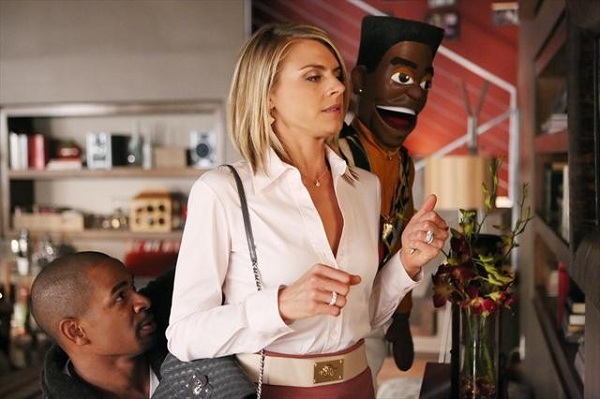A few days ago, SOS contributor Terence Johnson wrote about Fox’s new show The Following, and the key characters who turned out to be bisexual in the latest episode, titled “Mad Love”. This is an idea that would have been unfathomable in the early days of television, and remains a rare thing to see even today.
However, The Following is not the first show to open up this aspect of a primary character this season. On the eleventh episode of the ABC hit Happy Endings, titled “The Ex Factor”, Jane Kerkovich-Williams, one half of the show’s married couple, revealed that a past relationship with another woman actually had a much deeper emotional connection than her husband Brad had expected, leading to an insecurity about their marriage on his part. The end of the episode revealed that Jane had had numerous partners of both genders, with no clear pattern as to whom she dated when.
While both shows presented the characters’ bisexuality as just another facet, rather than an episode-stopping revelation, there are still a few fundamental differences in how they come across. While Paul and Jacob on The Following are now both unambiguously bisexual, they are still, disturbingly, cold-blooded killers and child kidnappers, seemingly relishing these roles. Happy Endings’ Jane, on the other hand, had her bisexuality revealed after more than 2 seasons, during which she was shown as a loving wife, supportive sister and friend, fastidiously organized, intensely competitive, excellent at her current job as a car salesman, one-time huge fan of early 2000s Gwen Stefani (even modeling her fashion choices after the No Doubt frontwoman), and possibly possessing the ability to turn into a fly at will. The audience has gotten to know Jane as a person, complete with virtues and flaws, and have been given the opportunity to decide whether they like her or not before any notion of her bisexuality was brought up.
The Following, on the other hand, aired only its fourth episode last night, which included a pilot where Emma, Paul and Jacob were all undercover, meaning the audience has only had two episodes and change to really get to know these people. In these episodes, the trio have, in two separate instances, kidnapped a child and a young woman, with a third kidnapping occurring offscreen, have been shown killing even their own relatives, and falling under the influence of serial killer and cult mastermind Joe Carroll. The only real humanizing points for these characters has been the reveal of an overbearing mother, a jilted lover angle that first hinted at the bisexual nature of one of the characters, and one person’s inability to actually kill when push comes to shove. In other words, the defining characteristic of the bisexual characters on The Following, by and large, is the fact that they are clearly bad people and the villains of the proceedings.
So what does this all mean? Well, The Following’s narrative to date has been about damaged characters. And an unfortunate result of this is that the bisexuality of characters who, until this point, have been portrayed as quite damaged feeds into the common misconception of bisexuality as deviant behavior, something practiced by people who aren’t quite right in the head, as Emma, Paul, and Will clearly aren’t. While the writers may genuinely be trying to bring in more sexual diversity in primetime television—and any efforts to do so must be applauded—the storytelling choices they have made to date leads to the opposite effect, reinforcing negative connotations that persist in society surrounding bisexuality.
Happy Endings, on the other hand, with the reveal of Jane’s bisexuality, threw a real wrench in the works. Jane and Brad’s marriage has yet to hit a major bump throughout the show’s run to date (none of the couple’s quibbles have yet to carry over into multiple episodes), and the two are quite content with each other, even getting kicked out of restaurants for illicit behavior towards each other in public washrooms. And as pointed above, Jane’s character has been completely fleshed out, and she has been shown as an upstanding member of society, beloved by many, and acknowledged as a believable, relatable character all around. Taking a character like Jane and revealing that she is bisexual does a lot towards challenging perceptions of what bisexuals are like and how they behave, and forcefully underlines the idea that one’s sexual orientation doesn’t predetermine what kind of person they end up becoming.
Ultimately, the presence of more bisexual characters on television is a good thing. But thought not only needs to be given to whether or not to portray characters as being bisexual, but how the characters are portrayed independent of their sexual preferences. Consideration of how bisexuals on television come across to the audience is a very important factor to consider, and while it is commendable that shows as different as Happy Endings and The Following are both choosing to make key characters bisexual, the differences in how said characters are otherwise portrayed makes all the difference in whether they ultimately end up being positive or negative models of bisexuality. That, above all, cannot be ignored if these, and other, shows intend to be a beacon towards acceptance.
– Deepayan Sengupta





